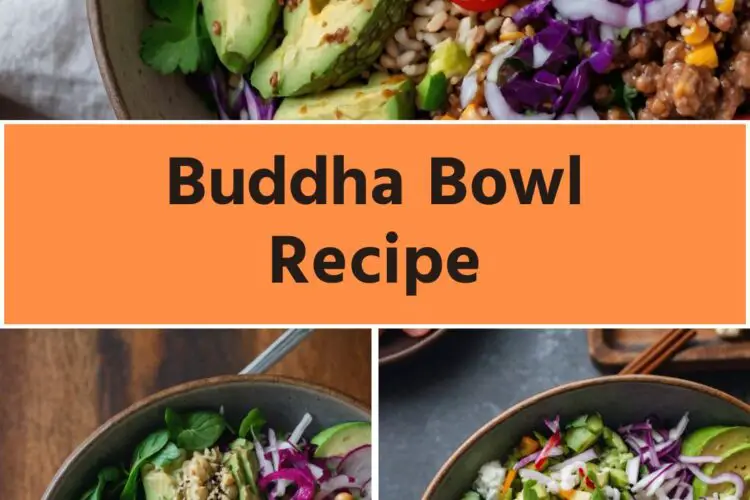Before diving into the details of crafting your Buddha bowl, let’s consider what you can pair with it. These bowls are highly adaptable and can be complemented with several delightful accompaniments.
1. Fresh Salsa: A zesty tomato salsa can add a punch of flavor. The acidity enhances the overall dish.
2. Guacamole: Creamy avocado played here can provide richness while balancing textures.
3. Tahini Dressing: A drizzle of tahini sauce enhances the nutrition profile and elevates flavor depth.
4. Whole Grain Pita Chips: For a crunchy side, nothing beats these. They provide contrast to the soft veggies and grains.
These suggestions can elevate your Buddha bowl experience, making it not just a meal, but a feast of flavors.
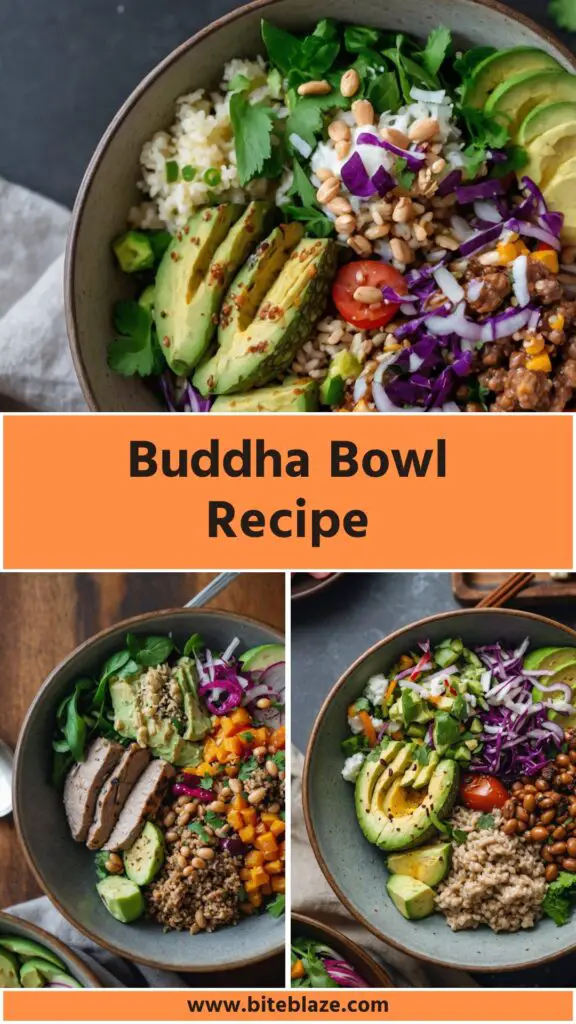
Buddha bowls have taken the culinary world by storm. They boast a plethora of colors, textures, and flavors all in one hearty bowl. I remember the first time I tried one – it felt like a comforting hug after a long day. These bowls are more than just a sight for sore eyes. They represent balance, nutrition, and creativity. If you’re looking for a meal that’s packed with goodness, look no further. This Buddha bowl recipe will remind you that healthy eating can be quite exciting.
What is a Buddha Bowl?
At its essence, a Buddha bowl is a balanced meal comprising grains, vegetables, proteins, and healthy fats served in a single bowl. Typically colorful and nutrient-dense, these bowls often include greens, grains, toppings, and sauces. Who wouldn’t like to dig into something that looks like art, tastes delicious, and nourishes the body at the same time?
Why This Recipe Works
Here’s why this Buddha bowl recipe is a standout choice:
1. Nutrient Diversity: Each ingredient brings its own unique blend of vitamins and minerals. For instance, leafy greens are rich in iron and calcium, while avocados provide healthy fats.
2. Flavor Explosion: The combination of sweet peppers, savory edamame, and zesty dressings creates an orchestra of taste. Every spoonful is different, keeping your palate intrigued.
3. Customizable Base: You can adjust the ingredients based on seasonal produce or personal preferences. Don’t fancy edamame? Swap in chickpeas.
4. Simple Preparation: This dish doesn’t require any culinary expertise. With easy-to-follow steps, anyone can create a delectable Buddha bowl in no time.
You will also like the following Salad recipes!
Ingredients You’ll Need To Make This Buddha Bowl Recipe
Here’s what you’ll require to whip up your very own Buddha bowl:
- Base Ingredients:
- 4 cups shredded red cabbage, baby spinach, chopped romaine, or kale (stems removed)
- 1 ¼ cups short or long-grain brown rice, rinsed
- 1 ½ cups frozen shelled edamame beans (organic recommended)
- 2 ripe avocados, halved, pitted, and sliced
- ½ cup finely diced red bell pepper
- 1 ½ cups chopped sugar snap peas, snow peas, or thin-cut broccoli florets
- 1-2 tablespoons low-sodium tamari or light soy sauce
- 4 cups shredded red cabbage, baby spinach, chopped romaine, or kale (stems removed)
- Flavorful Garnishes:
- 1 small cucumber, thinly sliced
- Carrot-ginger dressing (homemade or ready-made)
- 2 tablespoons chopped green onions
- Fresh lime wedges
- Toasted sesame oil for drizzling
- Toasted sesame seeds
- Flaky sea salt for finishing touches
- 1 small cucumber, thinly sliced
I highly recommend using fresh, high-quality ingredients. The better the base, the better your Buddha bowl will turn out!
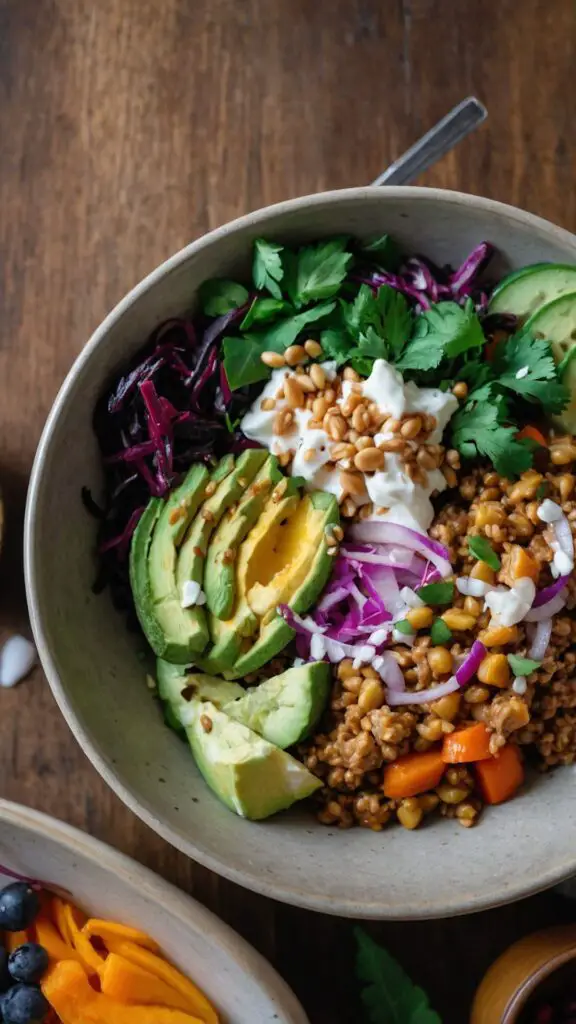
How To Make This Buddha Bowl Recipe
Let’s break it down step by step.
Step 1: Cook the Rice
In a medium saucepan, combine 1 ¼ cups of brown rice with 2 ½ cups of water. Bring to a boil, then reduce the heat to low and cover. Cook for about 35-40 minutes until rice is tender. Once done, fluff it with a fork.
Step 2: Prepare Vegetables
While the rice cooks, chop your veggies. Slice the red bell pepper, sugar snap peas, and cucumber. These vegetables will be the colorful stars of your bowl!
Step 3: Cook Edamame
In a separate pot, bring water to a boil. Add in the frozen edamame and cook for about five minutes. Drain and set them aside.
Step 4: Assemble Your Bowl
Grab a large serving bowl. Begin with a layer of cooked rice, followed by the leafy greens. Top that with your colorful veggies and edamame.
Step 5: Add Avocado and Dressing
Just before serving, add the sliced avocados for that creamy texture. Drizzle everything with your carrot-ginger dressing, tamari sauce, and any other garnishes you desire.
Step 6: Serve It Up
Garnish with sesame oil, seeds, green onions, and perhaps a squeeze of lime juice. Voila! You’ve crafted a Buddha bowl.
Tips for Crafting the Perfect Buddha Bowl
- Prep in Advance: Cook the rice and chop veggies a day ahead. This makes assembly quicker when you’re ready to eat.
- Balance Your Ingredients: Aim for colors and textures. A good variety makes it visually appealing.
- Experiment with Proteins: Add in grilled chicken, tofu, or different beans to change the protein source.
- Marinate Your Ingredients: A light marinade can infuse flavor. Try marinating your edamame in soy sauce for an hour before assembly.
- Serve Warm or Cold: This dish is versatile. Feel free to enjoy it hot straight from the kitchen or chilled if prepped ahead.
Nutrition Information
Each serving roughly contains the following (based on standard ingredient use):
- Calories: 500
- Protein: 18g
- Fat: 25g (healthy unsaturated fats from avocado and sesame oil)
- Carbs: 60g
- Fiber: 14g
These bowls are not just filling; they’re loaded with nutrients that keep you energized throughout the day.
How to Store the Leftovers?
If you’ve managed to have leftovers, you can easily store them. Place the assembled bowl in an airtight container. It will stay fresh in the fridge for about 3 days. Keep dressing on the side to avoid soggy ingredients.
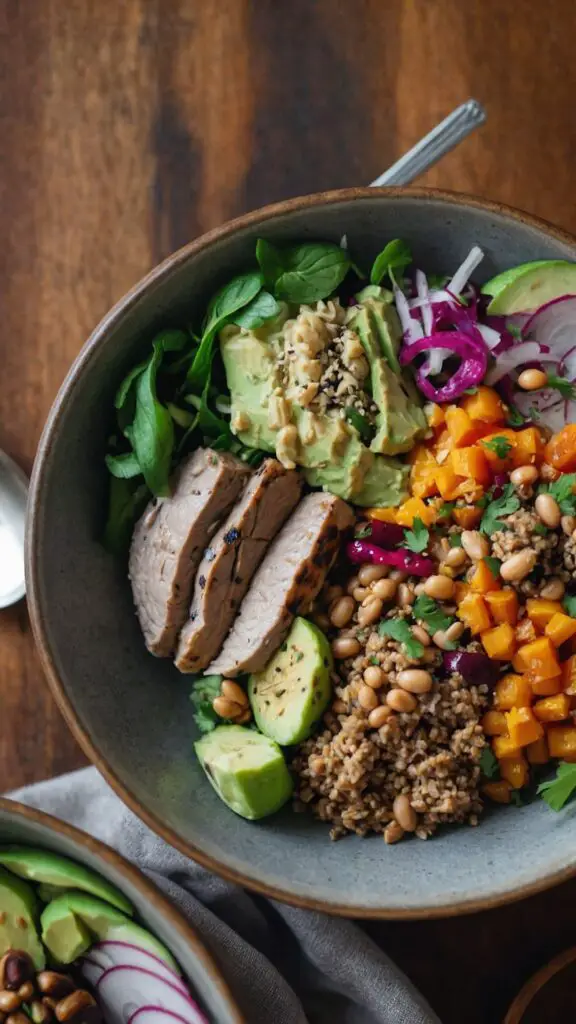
Recommended Side Dishes for Buddha Bowl Recipe
Here are some side dishes that complement a Buddha bowl nicely:
1. Quinoa Salad: It’s refreshing and offers a protein boost. Combine quinoa with cucumber, cherry tomatoes, and a zesty dressing for a nice side option.
2. Hummus and Veggies: A platter of fresh veggies dipped in hummus will add crunch and flavor balance.
3. Stuffed Peppers: Use leftover grains or veggies stuffed in bell peppers. They make a colorful and nutritious addition.
4. Roasted Sweet Potatoes: These naturally sweet, caramelized nuggets add a lovely contrast of flavor to your bowl.
Combining these sides can enhance your overall meal.
Ingredient Substitutions
If you find yourself missing certain ingredients, here are some alternative options:
1. Rice Alternatives: If you don’t have brown rice, quinoa or farro work as excellent bases.
2. Edamame Substitute: Chickpeas or black beans can replace edamame, providing different textures and tastes.
3. Avocado Replacement: If you’re not a fan of avocado, consider using tahini or a dollop of Greek yogurt for creaminess.
4. Leafy Greens: Spinach or mixed greens can step in if kale or cabbage isn’t available.
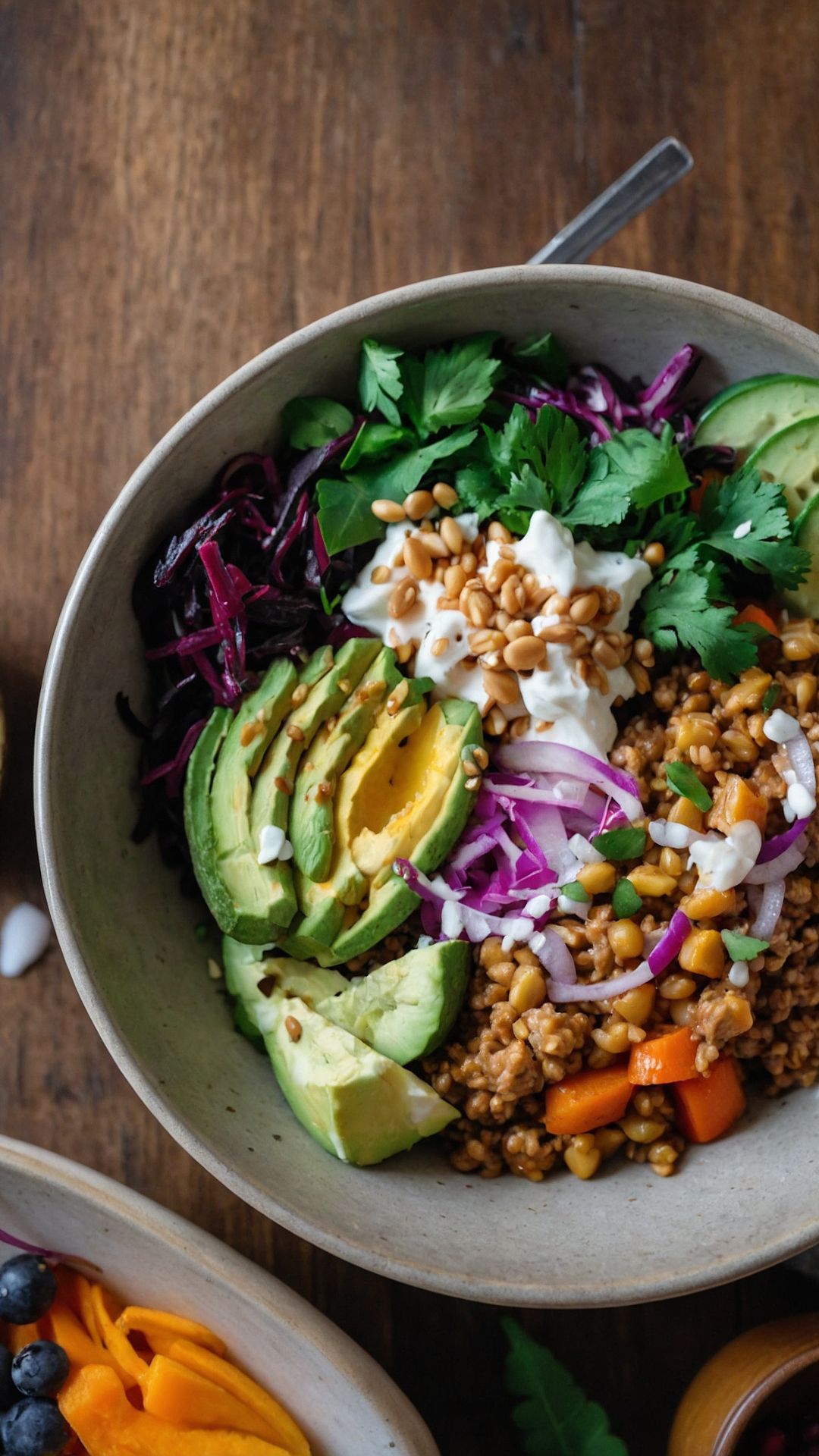
Buddha Bowl
Ingredients
Equipment
Method
- In a medium saucepan, combine 1 ¼ cups of brown rice with 2 ½ cups of water. Bring to a boil, then reduce the heat to low and cover. Cook for about 35-40 minutes until rice is tender. Once done, fluff it with a fork.
- While the rice cooks, chop your veggies. Slice the red bell pepper, sugar snap peas, and cucumber. These vegetables will be the colorful stars of your bowl!
- In a separate pot, bring water to a boil. Add in the frozen edamame and cook for about five minutes. Drain and set them aside.
- Grab a large serving bowl. Begin with a layer of cooked rice, followed by the leafy greens. Top that with your colorful veggies and edamame.
- Just before serving, add the sliced avocados for that creamy texture. Drizzle everything with your carrot-ginger dressing, tamari sauce, and any other garnishes you desire.
- Garnish with sesame oil, seeds, green onions, and perhaps a squeeze of lime juice. Voila! You’ve crafted a Buddha bowl.
Nutrition
Notes
- Prep in Advance: Cook the rice and chop veggies a day ahead. This makes assembly quicker when you’re ready to eat.
- Balance Your Ingredients: Aim for colors and textures. A good variety makes it visually appealing.
- Experiment with Proteins: Add in grilled chicken, tofu, or different beans to change the protein source.
- Marinate Your Ingredients: A light marinade can infuse flavor. Try marinating your edamame in soy sauce for an hour before assembly.
- Serve Warm or Cold: This dish is versatile. Feel free to enjoy it hot straight from the kitchen or chilled if prepped ahead.
Tried this recipe?
Let us know how it was!Frequently Asked Questions
1. Can I make this Buddha bowl vegan?
Absolutely! This recipe is already vegan-friendly, especially if you use plant-based dressings.
2. How can I make this meal gluten-free?
Opt for gluten-free tamari instead of light soy sauce and ensure your dressings are also gluten-free.
3. Can I prepare the Buddha bowl the night before?
Yes! Just assemble your ingredients, keep the dressing separate, and mix before serving for the best taste.
4. How can I add more protein to my bowl?
Consider adding grilled chicken, shrimp, or a scoop of hummus for an additional protein boost.
5. Is this recipe customizable for different dietary restrictions?
Yes, it is highly adaptable. You can adjust ingredients to fit vegetarian, vegan, gluten-free, or nut-free diets.
Conclusion
Crafting a Buddha bowl is a fun and rewarding journey. It allows for creativity while ensuring you consume a balanced meal packed with nutrients. This recipe not only satisfies your taste buds but nourishes your body. Before you know it, you’ll find yourself inventing new flavor combinations to include in your bowls.
So, what are you waiting for? Grab those freshest veggies from your local market, gather your grains, and get to crafting your personalized Buddha bowl. Happy cooking!

